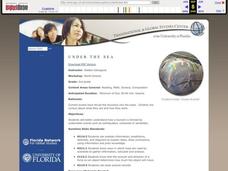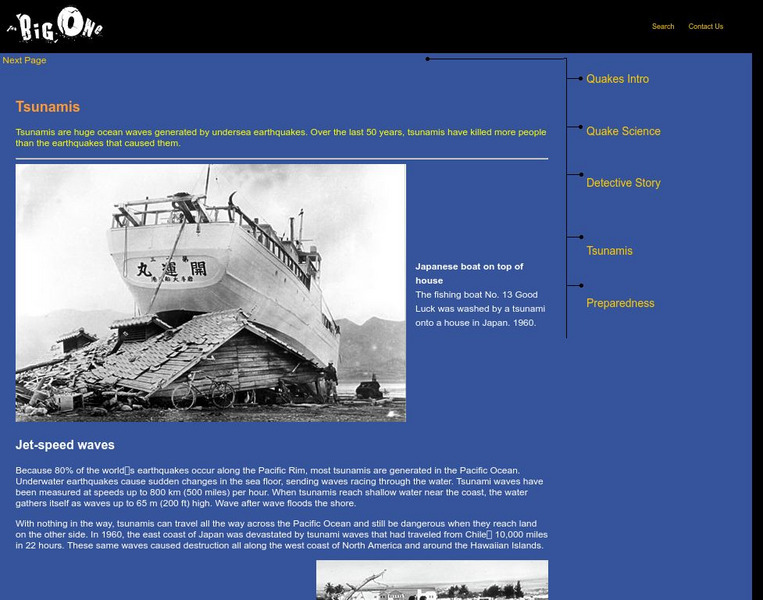Curated OER
Under The Sea
Second graders study how a tsunami is formed by underwater events such as earthquakes, volcanoes or landslides. They discuss what they knew about living and non-living things in the ocean.
Curated OER
Asian Tsunami
Students discuss natural disasters, global community and address Students concerns and worries. They review thoughts about the tsunami written by students logging onto the Newsround website and determine which statements they relate to.
Curated OER
Monster Waves
Students investigate tsunamis by creating a tabletop village and use it to visualize the relative height and effects of tsunamis. Each group builds a difference section of the city or village and as a class they decide who build what and...
Curated OER
Forces of Change
Second graders discuss various ways in which landforms change over time. They, in groups, research and create a reference book about landform change including tsunamis, earthquakes, weathering, erosion and volcanic eruptions.
Curated OER
Tsunamis by the Book
Learners use the Internet and other sources to investigate tsunamis. They construct books listing several tsunami facts and cite their sources. They read their books to another class.
Curated OER
The Science of Tsunamis: Seeking Understanding in the Wake of Tragedy
Learners use Internet research, articles, discussion and models to explore the dynamics of a tsunami. They focus on the 2004 Asian Tsunami and create posters illustrating their understanding of this phenomenon.
Curated OER
Tsunami Word Chop Worksheet
In this tsunami word puzzle worksheet, students analyze a table of 16 words that have been chopped in half. Students find the pieces that fit together and write them on the lines. There is no word bank; all words pertain to tsunamis.
Curated OER
World's Most Dynamic Force
Students explore the Earth's forces. They review an assessment task and its accompanying rubric. They classify ten items as long-term or short-term interactions of the Earth's components and rank the destructive impact of the forces. ...
Curated OER
Calm After the Storm
Young scholars create posters providing information about Sri Lanka's history and society both before and after the tsunami. They write response papers considering the future of this small country devastated by the natural disaster.
Curated OER
"Tsunamis"
High schoolers visit a PBS Website about tsunamis to consider their causes, effects and steps countries have taken to try to defend against them. They answer questions and create a brochure explaining tsunami facts and procedures to...
Curated OER
How Did This Happen?
Pupils use websites and discussion to investigate the 2004 Asian Tsunami. Students identify the Indian Ocean coastline's physical, political and human geography features and consider how they affected loss of life and property in those...
Burke Museum
Burke Museum: The Big One
This is the introduction to the Burke Museum's online exhibit on earthquakes and natural disasters. This is part of the Burke Museum's collection of geology. Topics that are covered include an introduction to quakes, quake science, quake...
Burke Museum
Burke Museum: Tsunamis
The information on tsunamis provided at this site is part of the Burke Museum's online exhibition on earthquakes and geology. Prevention is discussed, along with famous tsunamis in history.
PBS
Pbs Learning Media: Volcanic Eruptions and Hazards
This interactive resource adapted from the National Park Service illustrates the difference between explosive and effusive volcanic eruptions, as well as the hazards that can result, including lahars, tsunamis, and lava flows.
University of Southern California
University of Southern California:tsunami Research Group
This site provides a world map of locations of past tsunamis, some video/animations of tsunamis, and a list of additional links to related topics.
Woods Hole Oceanographic Institution
Woods Hole Oceanographic Institution: Tsunami: An Interactive Guide
A complete, interactive learning activity covering the science of tsunamis, preparedness, research, and historical tsunamis. Excellent animations and real, historical recordings of survivors allow the learner to experience what happens...
PBS
Pbs Nova: Wave of the Future
This media-rich essay from NOVA Online describes the challenges involved in installing a warning system for tsunamis in the Indian Ocean.
US Geological Survey
Usgs: Surviving a Tsunami
Here's a common sense site about what to do in case you are in the area of a tsunami. This site is very interesting in that it provides lots of pictures of the damage a tsunami can do. Lessons were learned after these particular tsunamis.
NOAA
Noaa: National Weather Service: Jetstream: Tsunamis
Online school for weather presents an abundance of information about tsunamis. Explore how they form, where they occur, how to prepare for one, and how to survive one. A review quiz and lesson plans are included for further enhancement...
Other
Earthquakes Canada: Tools for Teachers
This webpage offers an excellent collection of teaching resources about earthquakes, tsunamis, volcanoes, and much more. An extensive and extremely well-organized list of "frequently asked questions" regarding the topic, and live...
Ready
Ready
Explore the Ready website for an overview of how families and businesses can prepare for emergencies, threats, and disasters by building kits, making plans, and staying informed. Find safety information about biological threats,...
Teachnology
Teachnology: Guide to Tsunamis
For any educator preparing a teaching theme/unit on tsunamis, this is the site for you! Links to a myriad of lesson plans, worksheets, interactive sites, teacher resources, and much more are all found on this one site.
NOAA
Noaa: Center for Tsunami Research
National Oceanic and Atmospheric Administration's site for tsunami research of improved measurement technology, development and implementation of improved models and improved methods to predict tsunami impacts on the population and...
TeachEngineering
Teach Engineering: Survive That Tsunami!
Students use a table-top-sized tsunami generator to observe the formation and devastation of a tsunami. They see how a tsunami moves across the ocean and what happens when it reaches the continental shelf. Students make villages of model...
























